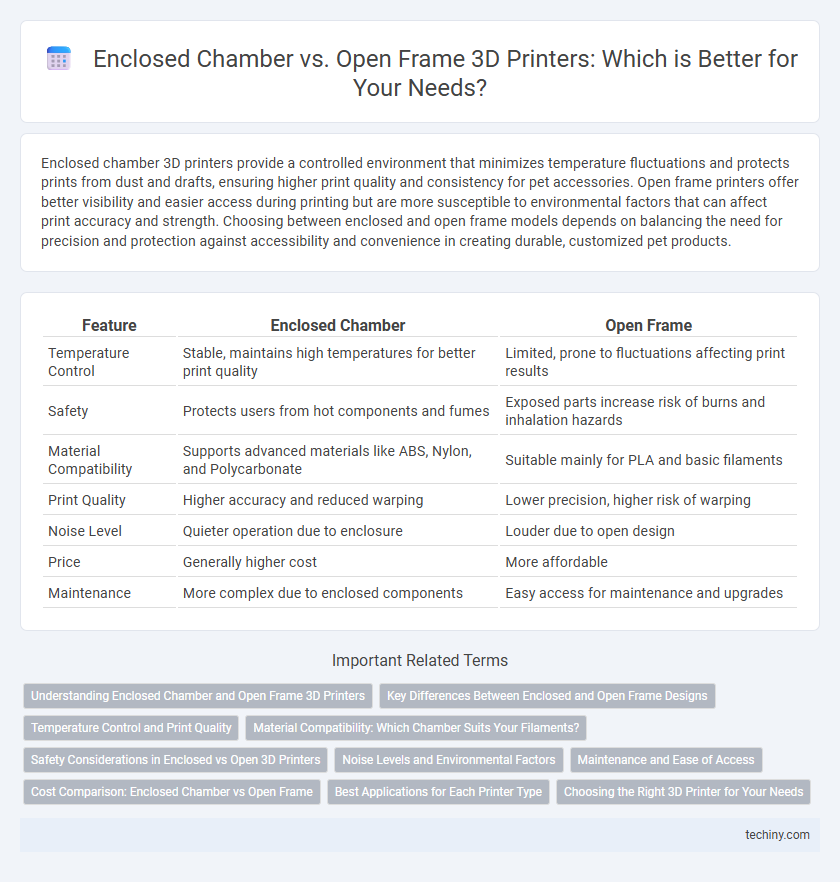Enclosed chamber 3D printers provide a controlled environment that minimizes temperature fluctuations and protects prints from dust and drafts, ensuring higher print quality and consistency for pet accessories. Open frame printers offer better visibility and easier access during printing but are more susceptible to environmental factors that can affect print accuracy and strength. Choosing between enclosed and open frame models depends on balancing the need for precision and protection against accessibility and convenience in creating durable, customized pet products.
Table of Comparison
| Feature | Enclosed Chamber | Open Frame |
|---|---|---|
| Temperature Control | Stable, maintains high temperatures for better print quality | Limited, prone to fluctuations affecting print results |
| Safety | Protects users from hot components and fumes | Exposed parts increase risk of burns and inhalation hazards |
| Material Compatibility | Supports advanced materials like ABS, Nylon, and Polycarbonate | Suitable mainly for PLA and basic filaments |
| Print Quality | Higher accuracy and reduced warping | Lower precision, higher risk of warping |
| Noise Level | Quieter operation due to enclosure | Louder due to open design |
| Price | Generally higher cost | More affordable |
| Maintenance | More complex due to enclosed components | Easy access for maintenance and upgrades |
Understanding Enclosed Chamber and Open Frame 3D Printers
Enclosed chamber 3D printers provide a controlled environment that maintains consistent temperature and reduces warping, ideal for printing advanced materials like ABS and polycarbonate. Open frame 3D printers offer greater accessibility and visibility during printing, making them suitable for beginners and educational purposes where ease of use and quick adjustments are prioritized. Choosing between enclosed and open frame designs depends on the specific printing needs, material types, and desired print quality.
Key Differences Between Enclosed and Open Frame Designs
Enclosed 3D printers feature a protective casing that maintains consistent internal temperature, reducing warping and enhancing print quality, especially with ABS and other temperature-sensitive materials. Open frame designs offer easier access for adjustments and monitoring but can be more prone to temperature fluctuations and contamination, affecting print reliability. Enclosed chambers also improve safety by containing fumes and moving parts, making them ideal for educational or office environments where exposure is a concern.
Temperature Control and Print Quality
Enclosed chambers in 3D printers provide consistent temperature control, reducing warping and improving layer adhesion for higher print quality, especially with materials like ABS or Nylon. Open frame designs lack thermal insulation, leading to temperature fluctuations that can cause print defects and dimensional inaccuracies. Maintaining a stable build environment in enclosed chambers ensures enhanced precision and reliability in complex or large-scale prints.
Material Compatibility: Which Chamber Suits Your Filaments?
Enclosed chambers provide a controlled environment essential for printing with temperature-sensitive filaments like ABS, Nylon, and polycarbonate, preventing warping and enhancing layer adhesion. Open frame printers, while more affordable and accessible, best support filaments such as PLA that require less temperature regulation. Selecting the appropriate chamber type directly influences print quality and material performance by matching environmental stability to the filament's thermal requirements.
Safety Considerations in Enclosed vs Open 3D Printers
Enclosed 3D printers offer enhanced safety by containing fumes, heat, and moving parts, reducing the risk of burns and inhalation of hazardous ultrafine particles during printing. Open frame 3D printers expose users to higher risks of accidental contact with hot components and filament emissions, making them less suitable for environments with children or untrained operators. Industrial-grade enclosed printers often include filtration systems and safety interlocks, further minimizing exposure to toxic fumes and mechanical hazards.
Noise Levels and Environmental Factors
Enclosed chamber 3D printers significantly reduce noise levels by containing operational sounds within a sealed environment, making them ideal for office or home settings. This design also controls environmental factors such as temperature fluctuations and dust exposure, ensuring consistent print quality and reliability. In contrast, open frame printers tend to be noisier and more susceptible to ambient conditions, which can lead to variable print results and increased maintenance.
Maintenance and Ease of Access
Enclosed chamber 3D printers typically require less frequent maintenance due to better temperature regulation and protection from dust and debris, enhancing print reliability. However, open frame models offer superior ease of access, allowing users to quickly perform adjustments, clean components, and troubleshoot issues. Choosing between the two depends on balancing the need for controlled printing conditions with the convenience of direct access for maintenance tasks.
Cost Comparison: Enclosed Chamber vs Open Frame
Enclosed chamber 3D printers generally come with a higher initial cost due to added materials and complexity, including insulated walls and environmental controls that stabilize temperature for improved print quality. Open frame models are typically more affordable, making them a popular choice for entry-level users or educational purposes, but they may lack the precision and consistency in harsher printing environments. When considering total cost of ownership, enclosed printers may justify their premium through reduced material waste and less post-processing, whereas open frame units offer lower upfront investment but potentially higher long-term maintenance expenses.
Best Applications for Each Printer Type
Enclosed chamber 3D printers excel in printing high-temperature materials like ABS and nylon due to controlled temperature and reduced warping, making them ideal for professional prototyping and industrial use. Open frame printers are best suited for beginners, educational purposes, and printing with PLA, providing easier access and visibility during the printing process. Each type serves different needs: enclosed chambers prioritize precision and material versatility, while open frames focus on accessibility and user-friendliness.
Choosing the Right 3D Printer for Your Needs
Enclosed chamber 3D printers offer better temperature control, reducing warping and improving print quality for ABS and other high-temperature materials. Open frame printers provide easier access and faster setup, ideal for beginners and PLA filament users. Selecting the right printer depends on your material requirements, workspace safety, and desired print precision.
Enclosed Chamber vs Open Frame Infographic

 techiny.com
techiny.com